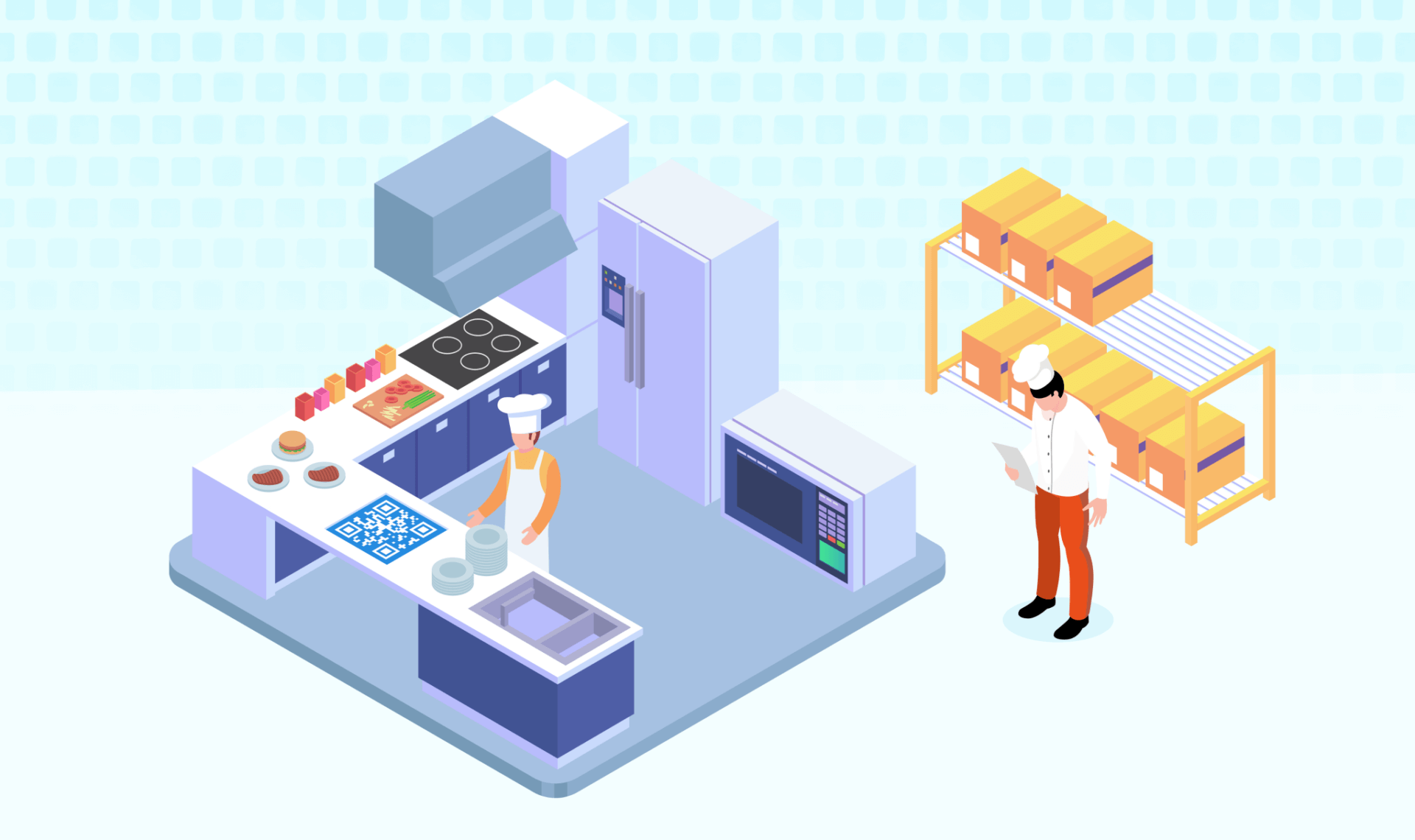While food costs can’t be eliminated — in the same way, you can’t fire your staff to eliminate payroll expenses— solid restaurant inventory management will prevent them from spiralling out of control.
After reading this guide you’ll have the tools you need to set up bulletproof protocols, keep track of F&B purchases, monitor stocklevels and outlet performance.
That means:
- No more guesswork in the F&B procurement department.
- No more wasting time searching through piles of spreadsheets.
- No more cost-swelling inventory blunders.
Instead, you can look forward to adding anywhere between 2 – 10% to your bottom line just by doing weekly inventory counts and fine-tuning your procurement (something Apicbase does automatically, shaving hours of work for your teams every week).

Sounds good?
In this article, we’ll cover:
- Why inventory management is important for all food service operations;
- What the common restaurant inventory mistakes are (& how to avoid them);
- 5 steps to creating robust restaurant inventory management SOPs;
- How to take your inventory game to the next level;
- How to take control of your food cost with restaurant inventory management software.
Ready for those profit margins to start busting at the seams?
Grab a fork and let’s dig in.
Why Restaurant Inventory Control is Essential

Why restaurant inventory management is critical? Well, you could just as easily ask why are a map and a compass important to mountaineers?
Because, without those two things, they’d have no idea where they are. Or where they’re going. Getting from point A to point B would turn into a string of dangerous overhangs, impossibly steep canyon walls, and ankle-twisting footpaths.
As a restaurant operator, you have your own treacherous overhangs and brambled footpaths — overstocking, understocking, waste, and pilferage.
Your obstacle is everything that makes it harder for you to get where you want to be. And where you want to be is running a successful foodservice business in which you max out the profits without sacrificing quality or customer experience.
(If you want your mind blown: check the 12 Restaurant Inventory Statistics That Highlight Why Inventory Control = Business Success.)
You see, restaurant inventory management is not about just having the numbers — it’s about what you do with them.
Everything inventory-related — including the four major benefits I’ll talk about here — is in the service of one goal…
… making sure that your actual food cost doesn’t differ from your theoretical food cost.
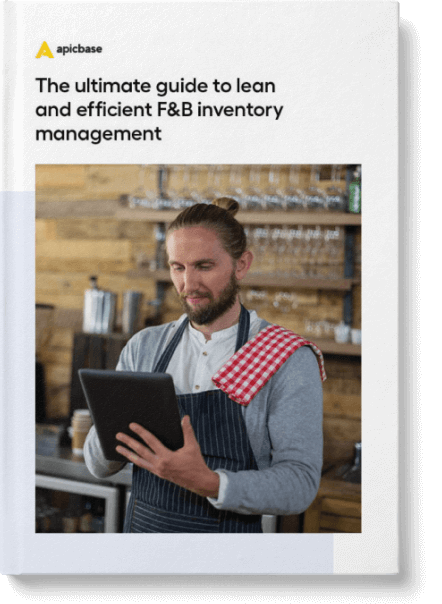
Get the Ultimate Guide to Lean and Efficient Inventory Management for Multi-unit Restaurants
A step-by-step guide for hospitality professionals to manage their Inventory.
Food cost variance is what we’re taking on, and you want it to be as close to zero as possible.
How do you get there?
You get there by fine-tuning your F&B inventory control and management, and reaping these four benefits of an on-point, replicable procedures:
- Knowing the overall health of your operation – let’s say you’re running a chain of fine-dining restaurants. You’re already walking a tightrope between slim margins on one end of the chasm and fickle customer sentiment on the other. Your inventory control needs to be polished because a single week of ‘off’ numbers can mean thousands in irrecuperable loss. There’s no room for error here. You either hit it out of the park or you’re stuck in one place, one major expense away from financial hardships. Good inventory management practices allow you to catch small errors before they snowball and turn into big issues.
- Informing operation-wide cost-saving decisions – a single large hotel generally has a couple of onsite restaurants and several cafes and bars. If you’re running an operation of that magnitude, you need access to real-time data. Otherwise, you’re just taking shots in the dark and hoping for the best. This is especially true for hotel chains where a wrong choice of a vendor can amount to hundreds of thousands in crippling (and unnecessary) costs. But, having a detailed overview of macro and micro inventory elements, as well as an ability to cross-compare relevant data, allows you to take swift action as soon as you realize something’s not adding up.
- Keeping over or understocking to a minimum – coordinating a large-scale catering service, one that potentially serves tens of thousands of meals every day, can quickly turn into an inventory management nightmare. If you overstock, you can bet you’re eating the cost of that food waste (unless you want to make a big client unhappy). On the other hand, if you understock, prepare for a barrage of angry emails from hangry people.The only way to stay profitable when serving businesses, government organizations, or hospitals is to ensure that your ingredient levels are strictly on par every single day — and that’s where your inventory management skills come into play.
- Taking control of waste and pilferage – on average, a US-based restaurant loses close to $80 per day to employee theft, with the waste amount generally being higher than that number. Now imagine running a 10-location multi-outlet operation. If you fall into the averages, you’re bleeding $1,600 every single day. Codified inventory management SOPs allows you to tamp this down and creates a level of control that makes it easier for you to identify and reduce waste, as well as discourage pilferage.
Recommended reading: The Ultimate Guide to F&B Purchasing for Multi-Outlet Restaurants
What Are Common Restaurant Inventory Management Mistakes?
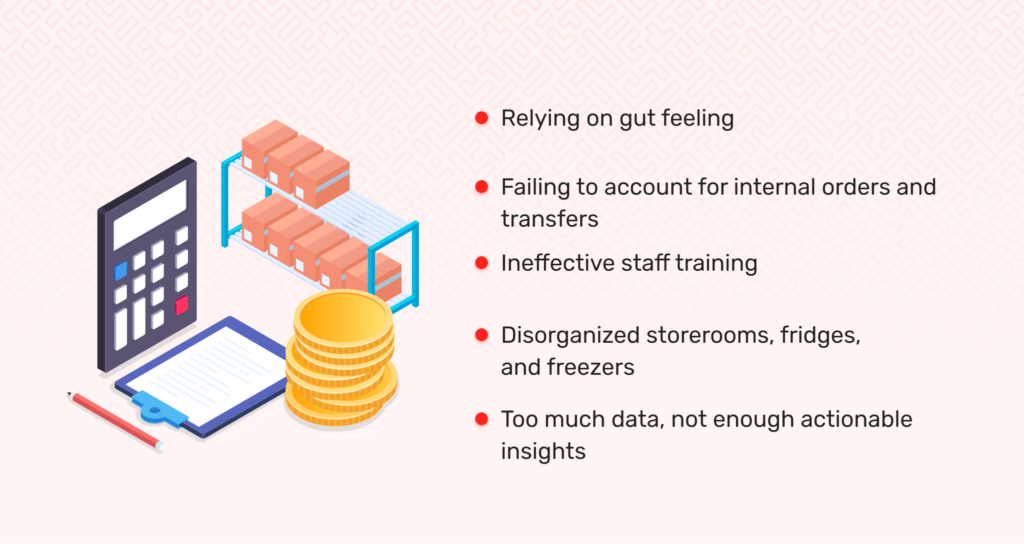
Whether you’re managing a single, high-end location, or a chain of hotel restaurants, it helps to remember that even the best restaurant inventory management practices are not infallible.
No matter how perfectly your numbers line up today, inventory is not a set-it-and-forget-it machine. A simple ingredient miscount (which happens way too often) is enough to throw off your calculations and forecasts unless caught and corrected in weekly inventory counts.
If you want to do inventory the right way, you need to organize, have a system in place, and periodically check, recheck, and tweak that system. By doing that, you will learn how to recognize and avoid these 5 most common restaurant inventory mistakes:
- Relying on gut-feeling to guide inventory processes
- Failing to account for internal orders and transfers
- Ineffective (or nonexistent) staff training
- Disorganized storerooms, fridges, and freezers, and
- Too much data, not enough actionable insights
Stock guesstimates are first on this list for a reason — they’re the first trap busy operators fall into when they try to cut corners to save time.
Once you start down this road, it’s difficult to have even a semblance of control over your inventory, costing, and purchasing because you’re not working with real, factual data. What you are working with are approximations that get progressively more inaccurate as time passes. (Learn more about the link between inventory & procurement management in multi-site restaurants).
Before you know it, €5 in daily unaccounted waste turns into €50, expensive ingredients regularly go missing without you even noticing, and your food cost spirals out of control.
How do you insure against this?
It’s easy…
Do. Your. Counts!
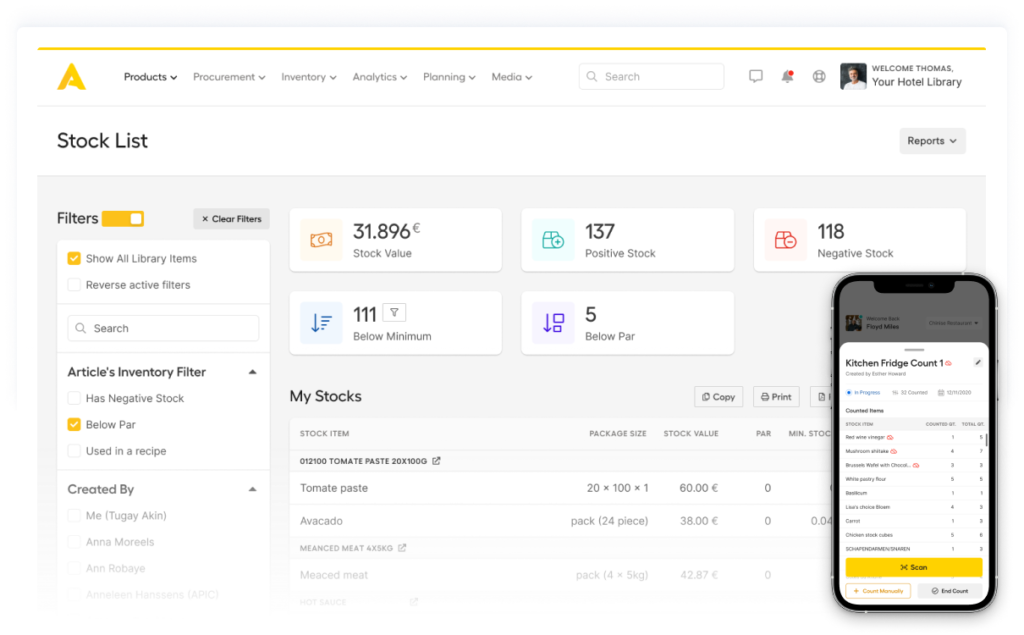
Once you’re working with the right numbers, everything inventory-related becomes easier — your ordering forecasts… your waste management… and your menu engineering.
Before you start working on your scalable inventory SOPs, make sure to go through this list of common restaurant inventory mistakes. Identifying the mistakes that you’re already doing will help you factor them into your inventory management battle plans.
5 Steps to Creating Robust Restaurant Inventory Management SOPs
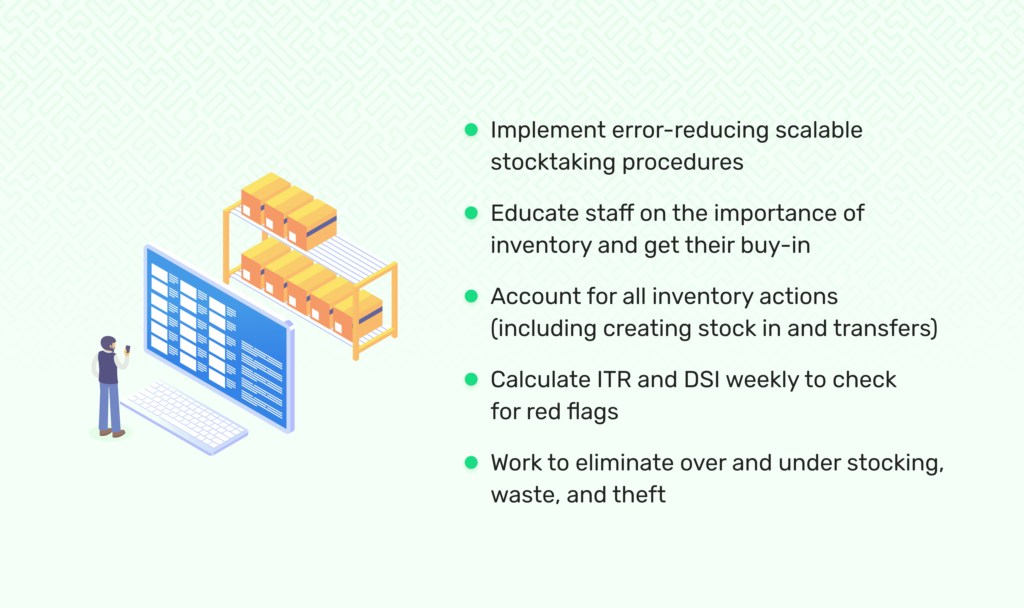
Having robust inventory management protocols that are both scalable and accurate is crucial to keeping food costs down and your profit margin busting at the seams.
For most F&B businesses, building solid SOPs is a five-step process that draws on established restaurant inventory best practices:
- Implementing error-reducing scalable stocktaking procedures
- Educating staff on the importance of inventory and getting their buy-in
- Accounting for all inventory actions (including creating stock in and transfers)
- Calculating ITR and DSI weekly to check for red flags
- Working to eliminate over and understocking, waste, and theft
Let’s run down the list.
1. Write Down Your Stock-Taking Procedure (& Stick to It)
We’ll start with stock-taking because everything inventory-related that comes after it depends on you working with the right fundamental numbers.
When taking stock, it’s best to follow a bulleted list of guidelines that outline the entire process from start to finish. Draw them up for your teams, and do occasional spot-checks on location to make sure they’re being followed.
Here’s an example (feel free to run with it word for word):
- Stock is taken in regular intervals at every location (weekly and monthly), with rotating daily checks for more expensive ingredients and items (caviar, wines, or prime cuts);
- Everything gets written down on the spot — the team has pen and paper, a tablet with spreadsheet capabilities, or a mobile inventory software with them to ensure accuracy;
- Stock-taking is a three-person job — two senior staff members who know the process, and a junior staff member who is learning the ropes of restaurant inventory management;
- Before the counting starts, storage areas are checked to make sure they are tidy, and that the ingredients are grouped together (especially important on delivery days);
- Everything is counted twice. If there is a discrepancy in the counts, they are repeated, and the third team member verifies the final count;
- Weekly counts are done on the same day (and at the same time) of the week. Rotating daily counts are done during the slow period of the day (early morning or afternoon);
- Inventory data is updated after every count, and available to everyone who needs it (shared software, spreadsheets, printouts), such as procurement, finance, accounts, etc.
Free Stocktaking Spreadsheet: Restaurant Food Inventory Template
2. Effectively Onboard Your Staff & Get Their Buy-In
Once you start making changes to how inventory is done across your operation, expect a grumbly chorus of: “but we’ve always done it this way” and “this is just extra pointless work”.
Right on cue, the resistant-to-changes human nature emerges (and if there’s anyone resistant to changes, it’s chefs).
Be patient — don’t butt heads by implementing changes overnight or by executive decision.
Instead, form a small task force – pick one person from each location, if you’re managing several – and ask for their opinion on how to streamline inventory practices, manage waste, and reduce the average food cost.
Nine times out of ten, you’ll be treated to groundbreaking ideas from people who are in the thick of it every day. And, you’ll end up with a strong and vocal core of advocates and stakeholders who are going to go back and sell your ideas to the rest of your teams.
The most important point that you have to get across to your staff is the savings that come with effective inventory management. Just implementing weekly counts can add up to 10% to your bottom line every year. What does this mean for them?
Well, some of that money will definitely go towards salary raises, more comprehensive benefits, and better kitchen tools and equipment that increases work environment safety and prevents painful incidents that involve hot pans or blunt knives. A win-win for everyone.
As you roll out your revamped F&B inventory management procedures, make sure to:
- Test it out at a single, best-suited location — give yourself a chance to iron out the kinks before rolling the SOPs out across your operation
- If possible, schedule staff swaps so that kitchen staff members from other locations get to work with people who are familiar with the methodology
- Develop and implement an on-the-job F&B inventory management training program for all new hires so they know what they’re doing from day one (and why it’s important)
- Spot-check locations to ensure that new practices are followed — don’t go through the trouble of implementation to end up with no follow-through and the same shoddy data
HINT – You can ensure staff buy-in goes a lot smoother if your proposed changes result in less work, not more. People will object to full daily counts and manual input into spreadsheets — they will be far less resistant to working with restaurant inventory management software that depletes used ingredients automatically and provides actionable insight through an intuitive and easy-to-read interface.
3. Keep Track of F&B Stock
You now have a stock-taking procedure in place, and your teams are committed to managing inventory the right way.
That ‘right way’ hinges on recording all inventory movements correctly.
What do we mean by inventory movements?
Inventory actions are all actions that alter the stocklevels of your F&B. They are either counted in or out of your opening stock count so that, at the end of the day, you’re left with the correct closing count.
Inventory actions include:
- New purchases
- Creating stock in (ingredients made in-house, such as broths and dressings)
- Creating stock out (depleting inventory used during the creating-in process)
- Transfers out (inventory moved to another location)
- Transfers in (inventory brought in from another location)
- Sold products
- Registered waste, shrinkage, breakage, and/or pilferage
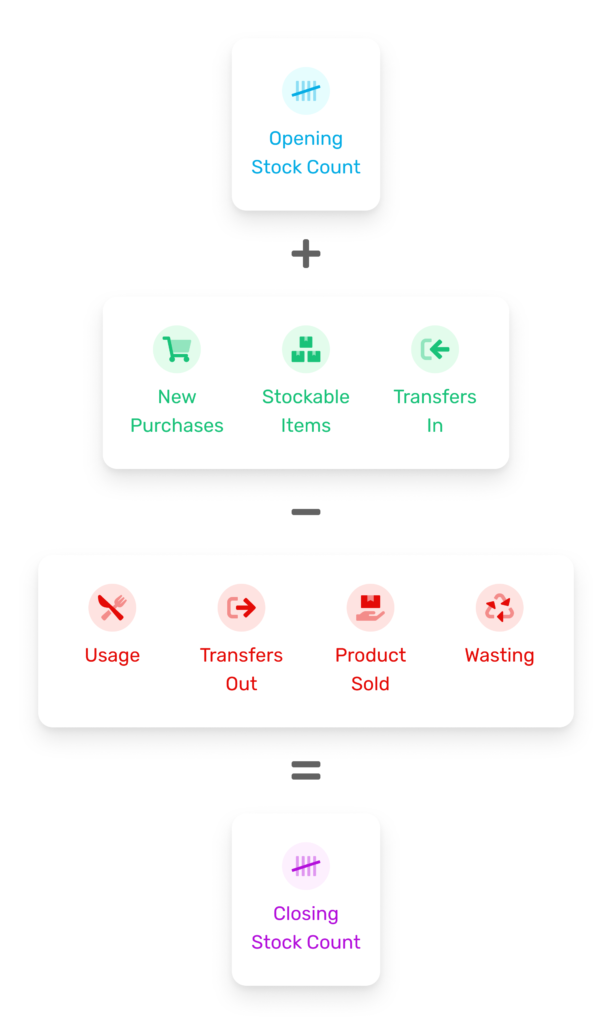
Why is tracking all inventory actions in a restaurant important?
Well, it’s the only way that you’ll be able to hone in on the causes for variance between your actual and ideal food cost (and close the gap).
Most of the time, what your PoS system records (for example, one pasta Bolognese or one chicken tikka masala) is all menu-level — this data tells you what you’ve sold but it doesn’t tell you how much stock was created-in, out, or wasted in the process of preparing a dish.
However, if you can keep on top of all your inventory actions (ideally with dedicated software that automatically makes inventory count adjustments based on menu items sold), half of your inventory control work is done.
Once you get this granular with your data, it’s easy to figure out if your food cost variance problem lies in excessive waste, over-plating, or theft, and to take necessary action to close the gap between ideal and actual variance.
4. Calculate Your ITR & DSI (& Check for Red Flags)
Unless you’re pulling your food cost variance insights from dedicated inventory management software, aiming for real-time data and 100% accuracy is a tall order.
After all, you’d have to update all your stock numbers daily AND run back-to-back calculations and analysis… not easy when you’re wrestling with cluttered spreadsheets.
But, that doesn’t mean that you can’t check the health of your inventory on a weekly basis. What you need are two handy restaurant inventory metrics that will tell you if you’re on track or serve as an inventory management red flag:
- Inventory Turnover Ratio (ITR) – tells you how rapidly your inventory sells — how many times have you replaced your entire stock in a given period (a month or a week), and;
- Days’ Sales in Inventory (DSI) – this one tells you how many days (on average) your food inventory sits on the shelves. Basically, it’s a number that tells you how many days worth you’re left with at the end of a given timeframe.
The industry average when it comes to inventory turnover rate is between 4 and 8. Anything below that means you’re overstocking (and dealing with a lot of waste), and anything above that means you’re likely frequently running out of menu items (and dealing with unsatisfied customers).
If your ITR is too low for your specific type of business, run the day’s sales in inventory. A high DSI number (higher than 10) is a final confirmation of overstocking, which means you need to get to work on identifying surplus ingredients.
Once you have your culprits, tweak your procurement practices and order lists, get down to those optimal on-par levels and stay vigilant so that overstocking doesn’t occur again. It will only lead to wasting and a higher food cost.
5. Use Data Insights to Drive Down Over and Understocking, Waste & Pilferage
Now that you’re working with accurate numbers and you’ve registered all your inventory actions correctly, knowing what to look for can be tricky.
High food cost variance is an immediate red flag, of course — if you’re constantly going over your projected percentages, you need to find the holes immediately and plug them. Otherwise, you’ll struggle to hit your yearly goals and grow your business.
However, food cost variance is not the only thing you should be looking at.
You’re going to have to whip up your calculator (or brush up on your Excel skills), and dive deep into the data — knowing things like average sitting inventory, optimal ingredient par levels CoGS, inventory turnover ratio (ITR), and day’s sales in inventory (DSI) will allow you to fine-tune your procurement processes and eke out an additional percentage point or two in profits.
Let’s take a quick look at a couple of scenarios that might be occurring across your operation.
Keep Tabs on Stock Without Daily Counts: Get Restaurant Inventory Management Software
5 Major Inventory Issues Only Data Analysis Will Uncover
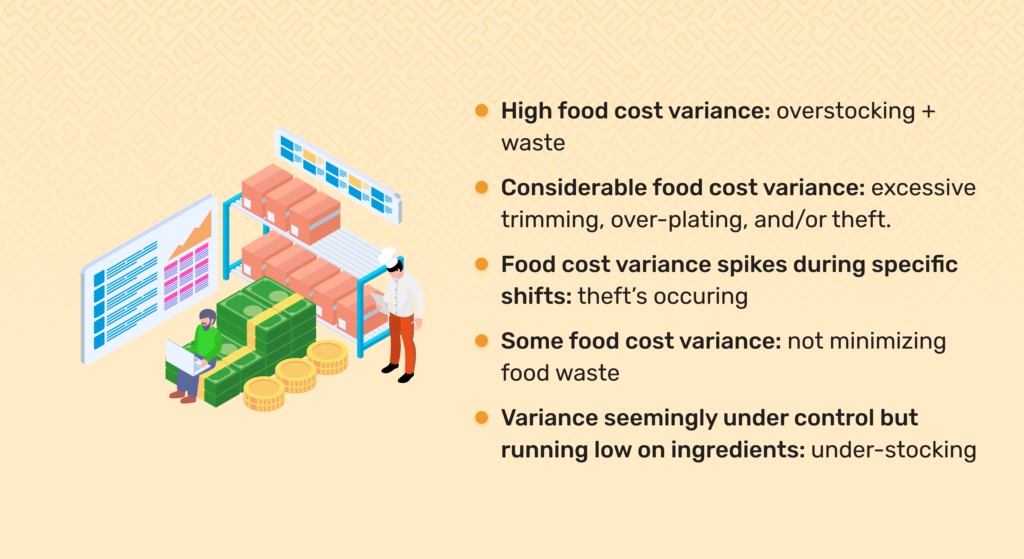
- High food cost variance (with low ITR and high DSI)—an open and shut case of overstocking. A lot of what you’re bringing in is simply sitting on the shelves and wasting away, and your team keeps using the same order lists week in and week out. To fix this, go through your stock, identify surplus items, and stop ordering them until the quantities fall under par levels.
- Considerable food cost variance (ITR and DSI within industry averages)—you are not overstocking but significant waste is occurring somewhere in the pipeline. The most likely culprits are excessive trimming, over-plating, and/or theft. To fix this, run a week-long food waste audit to pinpoint where wasting is happening, and train (or retrain) your staff on the correct food prep methods and plating.
- Food cost variance spikes during specific shifts (average ITR and DSI)—this situation is a red flag and it’s usually (but not exclusively) a sign that theft’s occurring at the location. It’s not that unusual for staff to skim a bit off the top — it’s estimated that pilferage costs the US restaurant industry a whopping $20 billion every year. Be firm — let your teams know about your suspicions, and say that you will be doubling down on inventory control. Usually, this is enough to discourage dishonest team members. In extreme cases, installing surveillance into your storerooms might be needed (though it’s not an ideal solution).
- Some food cost variance (high ITR and low DSI)—in this particular case, it’s most likely that you’re understocking and sacrificing both customer satisfaction and your bottom line in the process. The variance (although not high) is still occurring because you’re not doing a great job minimizing food waste. To fix this, use sales forecasts to order the correct quantities of stock you generally run out of (add a safety buffer on top of it) and audit your waste control to drive food cost down.
- Variance seemingly under control (but ingredient levels are constantly low)—don’t pat yourself on the back just yet because this is a classic case of understocking. You’re doing a good job managing food waste but your teams are constantly apologizing for having to 86 a menu item (damaging your sales and your hard-earned reputation). Revise your ingredient par levels to bring them up, and add a small safety margin before reassessing things during the following few weeks.
These (and similar insights) will allow you to make consistent improvements that help with keeping costs down and customers happy. By taking the time to calculate and uncover them (or using restaurant inventory management software to look them up in seconds), you’ll be able to improve your procurement, get the data you need for profit-boosting menu engineering, and finally start managing your restaurant’s food waste.
How to Take Your Restaurant Inventory Management to the Next Level?
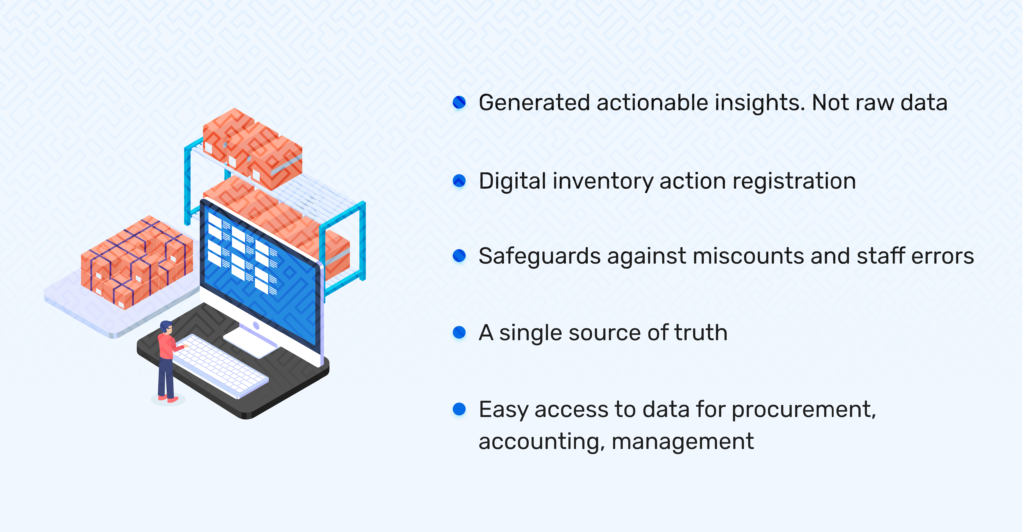
On-point, robust inventory management standard operating procedures help you keep track of your F&B stock, no matter how many outlets you run. It also provides an audit trail so you can track down errors, and a boatload of data to gather insights from.
But, for most foodservice businesses, simply having SOPs in place will not cut it.
If you run a single-location, fast-casual diner, you can (probably) get away with pen and paper, spreadsheets, and PoS-generated data.
But you’ll still have a lot of work to do to dig out actionable insights.
Everybody else – multi-outlets, hotel chains, and large-scale caterers – needs to go beyond procedures and start thinking about software.
By using a dedicated restaurant inventory management software, you’ll reap the benefits of:
- Auto-generated insights and actionable suggestions instead of just raw data
- Automatic inventory action registration and count adjustment
- Safeguards against miscounts and other staff errors
- Having a single source of truth to inform your decision-making process
- Easy access to data for all interested parties (procurement, accounts, management)
With software, your teams will work together, using the same (accurate) data to make significant, sometimes business-transforming decisions.
And, it goes without saying that it will be easier for you to keep track of everything without having to dig through spreadsheets, email threads, or WhatsApp messages. You can’t get to that place by using spreadsheets and pulling data from your PoS because those tools were not built for that.
12 Reasons Why Successful Multi-Unit Restaurant Businesses Use Apicbase to Manage Their Inventories
- Easy deployment – ditch those unruly spreadsheets and bulk upload your ingredient lists to start driving food cost down immediately.
- Immediate staff buy-in – stay late to count stock? Or leave an hour early every day? Your staff will love Apicbase for making the choice super easy.
- Auto-generated suggestions – I love data and insights. What I love more are smart and instantly useful software-generated suggestions. Courtesy of Apicbase.
- Ingredient-level stock tracking – Apicbase records all inventory actions, automatically depleting the counts when a sale is made (so you don’t have to think about it).
- Low-stock alerts – create alerts that will warn you when an ingredient drops below par levels — take immediate action and never 86 a menu item again.
- Digital stock-taking – arm your staff with tablets and watch them fly through those weekly stock counts (the numbers are immediately available organisation-wide).
- Instantly updated order lists – counts and inventory actions are fed into the procurement module, which creates accurate, cost-saving order lists.
- Stockable items management – creating-in a lot of broths and sauces? Keep accurate track of them directly in the inventory module to increase your inventory control.
- Internal orders reporting – Sending a crate of carrots to another outlet? Apicbase makes note of that, ensuring stock traceability and data validity for both locations.
- Food waste registration – stop recording food waste on post-it notes. Input that data into Apicbase immediately and draw up actionable plans to reduce waste.
- Historical trends overview – get historical inventory data and make sure to prepare for your busiest periods well in advance by increasing your orders when needed.
- Multi-outlet performance comparison – comparing performance between locations now takes a better part of the week? How about we turn that into two minutes, tops?
Take Control of Food Cost with Apicbase
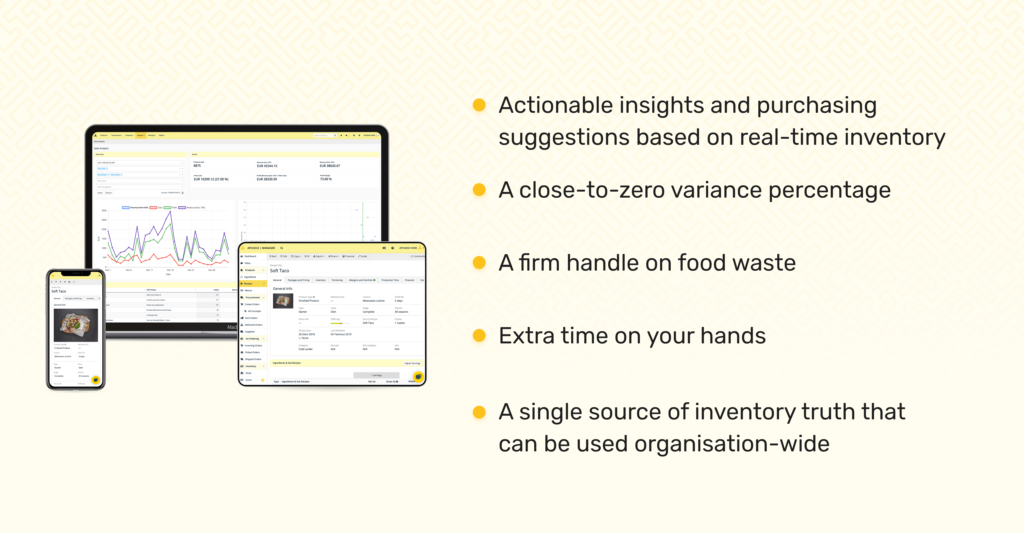
Here’s the deal — I know that restaurant inventory management is not sexy.
And it’s okay if you’re not psyched about it… the only people I know who are itching to talk about the intricacies of stock-taking or the value of the inventory turnover ratio calculation all work on the same floor here at the Apicbase office.
And that’s where you got lucky.
Instead of complex, spreadsheet-based restaurant inventory management — or worse yet, playing it by the ear — you get to take advantage of our unique maths and stats geekiness, and just move everything inventory-related to Apicbase.
You’ll get…
- Actionable insights and inventory suggestions based on real-time data
- A close-to-zero variance percentage that will be the talk of F&B conventions
- A handle on your food waste that will impress your customers
- More time on your hands than you’ll know what to do with
- A single source of inventory truth that can be used organisation-wide
…. and all of us here will get a warm, fuzzy feeling inside knowing that we’re empowering another restaurant business to bring their A-game to the table every day (okay, and some of your money too, but that’s peanuts compared to what you’ll be saving).
How does that sound?
If you’re tickled by the prospect of saving money without compromising on quality or customer experience, get in touch with us. Schedule a 30-minute demo (you pick the date and the time), and we’ll teach you how to make F&B inventory management sexy… fun… easier, faster and scalable.
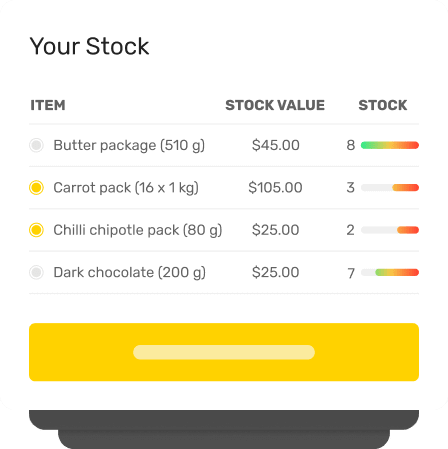
Schedule a demo today
In less than 30 minutes, you’ll discover how restaurant inventory management software adds to your bottom-line and boosts your business margins.
